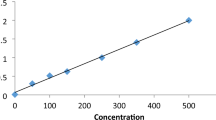Abstract
The fruits of Capsicum annuum were extracted using 80% aqueous MeOH, and fractionated using EtOAc and water. Repeated column chromatography using silica gel, octadecyl silica gel, and Sephadex LH-20 for the EtOAc fraction led to the isolation of a new lignan glycoside and a known one, icariside E5. From the results of spectroscopic data, including EIMS, FABMS, UV, IR, 1H and 13C-NMR, DEPT, and 2D-NMR (COSY, HSQC, HMBC), the chemical structure of the new lignan glycoside was determined as (8R)-isodehydrodiconiferyl alcohol-4′-O-(6″-vanilloyl)-β-D-glucopyranoside named vanilloylicariside E5. All isolated compounds were tested for antioxidant activities using 1,1-diphenyl-2-picrylhydrazyl (DPPH) assay. Icariside E5 (2) and (8R)-Isodehydrodiconiferyl alcohol (3) exhibited a strong scavenging effect on DPPH (2: IC50=42.1 µM, 3: IC50=4.5 µM).
Similar content being viewed by others
References
Almela, L., Lopez-Roca, J. M., Candela, M. E., and Alcazar, M. D. Carotenoid composition of new cultivars of red pepper for paprika. J. Agric. Food Chem., 39, 1606–1609 (1991).
Beltran, J., Ghosh, A. K., and Basu, S. Immunotherapy of tumors with neuroimmune ligand capsaicin. J. Immunol., 178, 3260–3264 (2007).
Garces, C. A., Gil, O. R., Alvarez, F. A., and Arnedo, A. M. S. Inheritance of capsaicin and dihydrocapsaicin, determined by HPLC-ESI/MS in an intraspecific cross of Capsicum annuum L. J. Agric. Food Chem., 55, 6951–1956 (2007).
Gupta, R. S., Dixit, V. P., and Dobhal, M. P. Hypocholesterolaemic effect of the oleoresin of Capsicum annum L. in gerbils (Meriones hurrianae Jerdon). Phytother. Res., 16, 273–275 (2002).
Higuchi, H., Fukui, K., Kinjo, J., and Nohara, T. Leguminous plants 29. Four new glycosides from Albizziae Cortex III. Chem. Pharm. Bull., 40, 534–345 (1992).
Iorizzi, M., Lanzotti, V., De Marino, S., Zollo, F., Blanco, M. M., Macho, A., and Munoz, E. New glycosides from Capsicum annuum L. var. acuminatum. Isolation, structure determination, and biological activity. J. Agric. Food Chem., 49, 2022–2029 (2001).
Izumitani, Y., Yahara, S., and Nohara, T. Novel acyclic diterpenes glycosides, capsianosides VI, G and H from Capsicum plants. Chem. Pharm. Bull., 38, 1299–1307 (1990).
Mabel, S. M., Feng, X. T., Thomas, C. W. M., and Henry, N. C. W., On the absolute structure of optically active neolignans containing a dihydrobenzo[b]furan skeleton. Tetrahedron, 54, 12429–12444 (1998).
Maoka, T., Mochida, K., Kozuka, M., Ito, Y., Fujiwara, Y., Hashimoto, K., Enjo, F., Ogata, M., Nobukuni, Y., Tokuda, H., and Nishino, H. Cancer chemopreventive activity of carotenoids in the fruits of red paprika Capsicum annuum L. Cancer Lett., 172, 103–109 (2001).
Materska, M. and Perucka, I. Antioxidant activity of the main phenolic compounds isolated from hot pepper fruit (Capsicum annuum L.). J. Agric. Food Chem., 53, 1750–1756 (2005).
Miyase, T., Ueno, A., Takizawa, N., Kobayashi, H., and Oguchi, H. Ionone and lignan glycosides from Epimedium diphyllum. Phytochemistry, 28, 3483–3485 (1989).
Moon, J. H., Tsushida, T., Nakahara, K., and Terao, J. Identification of quercetin 3-O-β-D-glucuronide as an antioxidative metabolite in rat plasma after oral administration of quercetin. Free Rad. Biol. Med., 30, 1274–1285 (2001).
PAO: major food and agricultural commodities and producers, http://www.fao.org/Ag/AGL/aglw/cropwater/pepper.stm (2001).
Reilly, C. A., Crouch, D. J., and Yost, G. S. Andrenyak, D. M., Detection of pepper spray residues on fabrics using liquid chromatography-mass spectrometry. J. Forensic Sci., 47, 37–43 (2002).
Sun, T., Xu, Z., Wu, C. T., Janes, M., Prinyawiwatkul, W., and No, H. K. Antioxidant activities of different colored sweet bell peppers (Capsicum annuum L.). J. Food Sci., 72, 98–102 (2007).
Tsai, T. H., Tsai, P. J., and Ho, S. C. Antioxidant and antiinflammatory activities of several commonly used spices. J. Food Sci., 70, 93–97 (2005).
Author information
Authors and Affiliations
Corresponding author
Rights and permissions
About this article
Cite this article
Lee, DY., Lee, DG., Cho, JG. et al. Lignans from the fruits of the red pepper (Capsicum annuum L.) and their antioxidant effects. Arch. Pharm. Res. 32, 1345–1349 (2009). https://doi.org/10.1007/s12272-009-2001-8
Received:
Revised:
Accepted:
Published:
Issue Date:
DOI: https://doi.org/10.1007/s12272-009-2001-8




